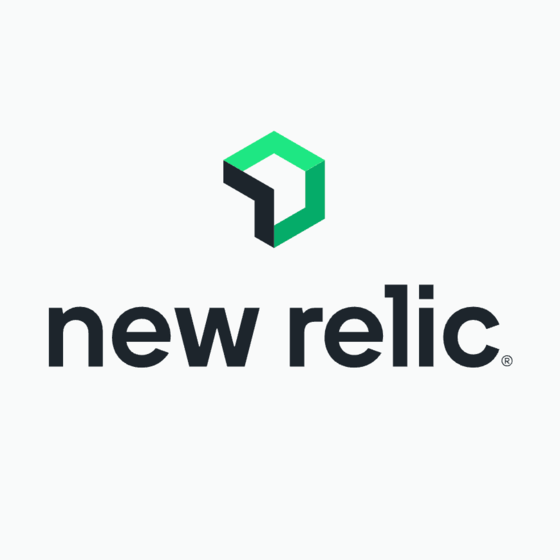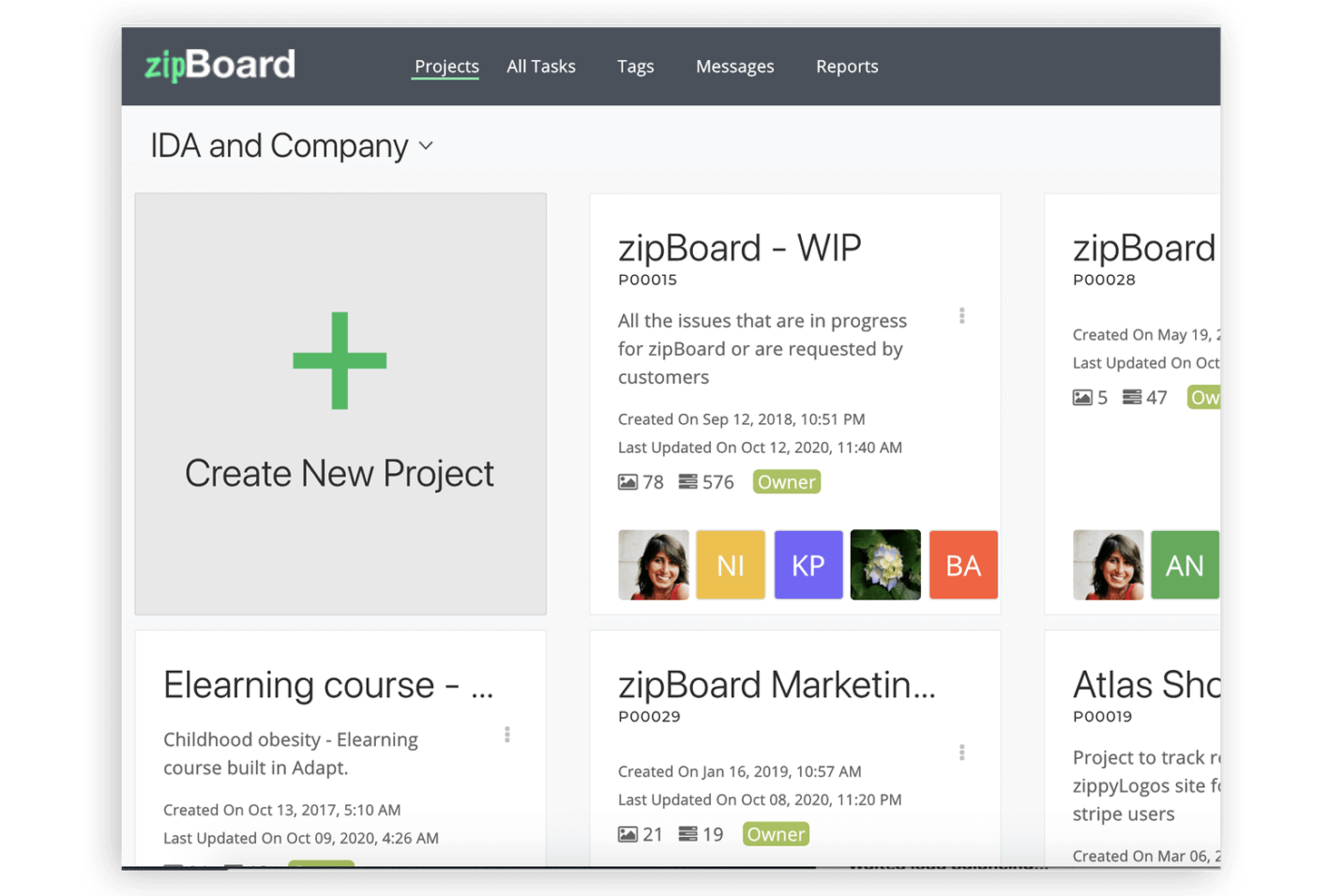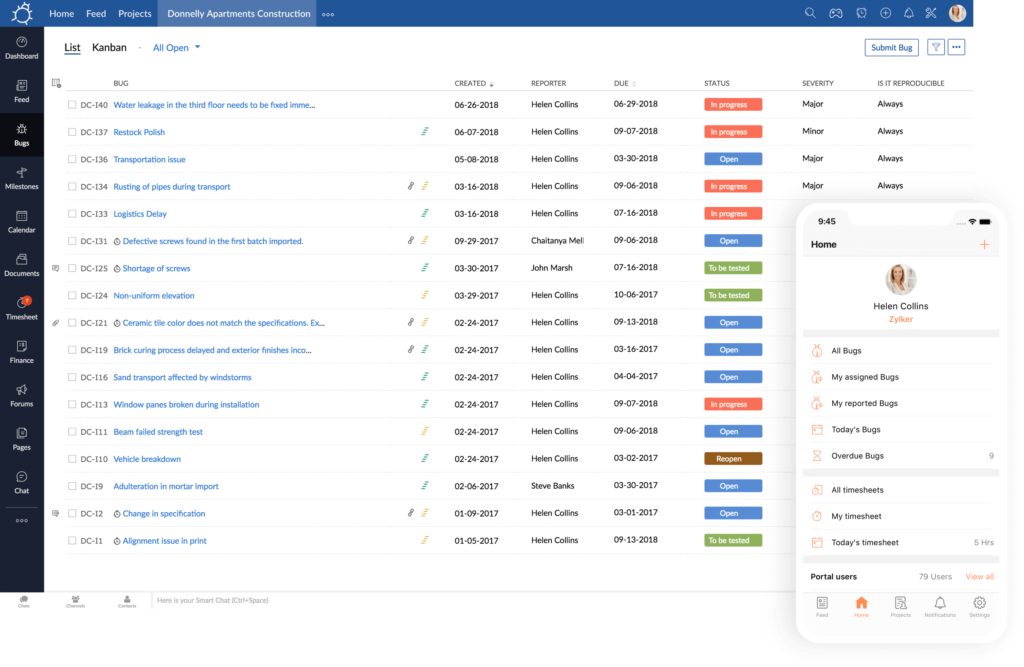10 Best Defect Tracking Tools Shortlist
Here's my pick of the 10 best software from the 20 tools reviewed.
There are seemingly countless defect tracking tools available, so figuring out which is best for you is tough. You want to record, manage, and track software defects but need to figure out which tool is the best fit. I've got you! In this post I make things simple, leveraging my experience using dozens of different defect tracking software to bring you this shortlist of the best defect tracking tools.
What Are Defect Tracking Tools?
Defect tracking tools are software used in the process of identifying, recording, and monitoring bugs or defects in software development projects. They provide a centralized system for managing information about identified software issues, facilitating the tracking of their status from initial report to resolution. These tools are an integral part of quality assurance in software development.
The benefits and uses of defect tracking tools include improving the quality of software by ensuring that all identified defects are systematically managed and resolved. They enhance communication and collaboration among team members, helping to prioritize and efficiently address software issues. By providing detailed records and analytics, these tools also aid in understanding defect trends and improving future development strategies. Overall, they contribute to increased productivity and transparency in the software development process.
Overviews Of The 10 Best Defect Tracking Tools For Software Testing
Here’s a brief description of each defect tracking platform on my list showing what it does best, plus screenshots to showcase some of the features.
New Relic is a SaaS product that's all about performance monitoring. It's designed to help you keep an eye on your software applications, making sure they're running smoothly and efficiently. It's like a health check-up for your software, identifying any potential issues before they become big problems.
I picked New Relic because New Relic APM 360 is designed to monitor your applications for defects, errors, and issues before they become a problem. Your team will gain the ability to effortlessly access concise health insights at each phase of development and across every layer of the stack. Furthermore, you can extract insights pertaining to specific lines of code, spanning from logs to infrastructure, swiftly pinpointing the underlying issue with minimal effort. Additionally, these insights encompass essential features like observing pivotal transactions, browser monitoring, and synthetic checks within the APM framework. These capabilities are meticulously crafted to eliminate monitoring gaps, effectively addressing issues like uninstrumented services, absent alerts, and vulnerabilities.
Standout features include the capability to immediately oversee essential performance indicators, map out interdependencies, and swiftly identify concerns through alert systems and error tracking mechanisms. Additionally, within the APM interface, you can gain insight into user experiences through pivotal transactions, synthetic checks, and browser monitoring. Their AI chat tool, New Relic Grok, can analyze your telemetry data and software stack to give you the right insights, root causes, and resolutions. Just ask it a question like, 'Why is my cart not working?'
Integrations include over 600 apps that include cloud platforms like AWS, Google Cloud, and Microsoft Azure, CI/CD tools like Jenkins, CircleCI, and Travis CI, communication tools like Slack and PagerDuty, and other monitoring and analytics tools like Grafana, Datadog, and Splunk. It also has an API you can use to build custom integrations.
New Relic has a free version available. Their paid plans start at $49/user/month and offer additional features, like SAML single sign-on, 24x7 support availability, 2-hour critical initial support response SLA, and additional data ingest per month.
Backlog is a cloud-based project management tool that is used by development teams and agile teams as an issue tracker and bug reporting tool. In addition to issue management, Backlog also provides you the ability to view your daily timeline and workflow by using Gantt charts.
Backlog provides development teams enhanced collaboration tools such as burndown charts, time tracking, progress tracking, and the ability to release code updates within the application. Team members can view each other’s tasks and updates real-time on customizable Kanban boards, which helps streamline processes and sprints.
Backlog integrates with Git which allows developers to effectively manage source code and project tasks. Backlog also integrates with applications such as Redmine, Typetalk, and Jenkins.
Backlog costs between $0 and $175 per user per month. The Enterprise Plan costs $1,200 for up to 20 users and has a 30-day free trial.
zipBoard is a visual bug tracker that allows you to review and collaborate on web projects using its central task manager. The tool provides the ability for your team to collect feedback on your digital content during the development lifecycle. zipBoard is also useful for teams that are developing e-learning courses, videos and PDF documentation.zipBoard provides you with review tools, allowing your non-technical stakeholders the ability to share reviews using annotations and screen recordings. This allows you and your team to better understand the issues at hand, and the tool allows you to build the results of those reviews within your development workflow. The tool also allows you to switch between table and Kanban views, providing your team the opportunity to view work together, assign tasks and organize priorities. zipBoard offers integrations with platforms such as Jira and Slack. zipBoard offers customized pricing upon request.
Rollbar is a bug tracking software that allows for coverage across all applications. The tool offers the ability to group similar cases into one set which allows for automatic organization, providing you the opportunity to focus solely on the task in hand as they occur.
Rollbar provides you with automatic notifications, allowing you to proactively review and debug your application in real-time. The tool provides you with information about the bug instantaneously, allowing you to assess the severity such as whether it is an isolated issue or whether it is occurring across the whole application so you are able to prioritize.
Rollbar provides integration with project management tools such as Asana, Jira, and Redmine, and integration with automation servers such as Jenkins and Azure DevOps.
The cost of Rollbar starts at $21.00 USD per month for the Essentials package. Rollbar also offers a free version with all the basic features.
Zoho Bug Tracker is a bug tracking tool with an easy-to-set-up web application that has features such as discussion boards and task boards, allowing you to check in on your team and monitor the progress of their work and enhance collaboration efforts. Zoho Bug Tracker also has a robust reporting feature that allows you to see clearly how many active bugs there are, making your team’s issue management seamless.
Zoho Bug Tracker is a scalable bug tracking software that allows you to track the life cycle of bugs from the onset to closure. The tool allows you to set up automatic notifications, and custom workflows to follow so you can fix bugs and close tickets faster. This allows you to automate issue management, so you are able to better focus on your clients and stakeholders’ needs.
Zoho Bug Trackers costs $4 per month for up to 10 users and offers a free plan for up to 3 users and 2 projects.
Trackduck is an issue tracking and visual feedback tool that allows you to track defects in the UX/UI phase of your project. Trackduck allows you to review tasks and comments with tech details directly within the website and allows you to easily filter your tasks with the Trackduck toolbar where you can assign bugs and track their progress.
Trackduck provides unique features to obtain feedback on your web projects throughout their life cycle. Team members and stakeholders can provide feedback on the likes of mock-ups and wireframes. With the assistance of the browser extension, you can record screenshots of your website, mock-ups, and wireframes, and get feedback using the public feedback feature.
Trackduck provides integration with project management software such as Asana, Jira, Redmine, and Trello.
Trackduck is an open-source application and source code can be viewed on GitHub.
Marker.io is a bug tracking tool that provides on-site bug reporting and automated addition of console logs. Marker.io also offers features such as customizable submission forms and fast mark-up tools for bug reporting and feedback collection, allowing you and your team to streamline your processes.
Marker.io allows you to create tickets directly from the web application into project management tools and issue trackers such as Jira, Github, Trello, and Asana. In addition, if you move a ticket in your project management tool, Marker.io will pull an “up-to-date” list, and the statuses automatically sync. The tool also allows you to collect feedback from clients and stakeholders and have it sync straight into your chosen project management tool, reducing the repetition of writing numerous tickets with the same details, increasing efficiency.
In addition to the above-mentioned integrations, Marker.io can also integrate with GitLab, Linear, Browserstack, Teamwork, and ClickUp. Marker.io also offers browser extensions such as Chrome and Firefox.
The cost of Marker.io starts at $39.00 USD per month (billed annually), and the service also offers a 15-day free trial.
MantisHub is a cloud-based issue tracking tool based off of MantisBT, which is a PHP application. MantisHub is ideal for development teams who wish to get started without the need to set up servers and install MantisBT. MantisHub is a quick setup and has a user-friendly interface, allowing team members with all levels of technical ability to collaborate.
MantisHub has an array of bug tracking features, including the built-in time tracking feature. The time tracking feature allows you to record the time spent on debugging manually or with a timer, providing the opportunity to get a better understanding of how long a bug would take to fix. The feature also offers bug reporting and as well as setting hourly rates for chargeback to your stakeholders and clients.
MantisHub offers integration with applications such as Slack, GitHub, GitLab, TestRail, and TestLodge.
The cost of MantisHub starts at $22.95 USD per month when paid annually for the Gold package, and the service also offers a free trial.
Bugzilla is an open source tracking tool that provides an advanced search system and a comprehensive reporting tool so you are able to generate charts and automated scheduled reports.The tool boasts a simple user interface, allowing beginners the opportunity to learn quickly, making it easy to implement within your team. Bugzilla also provides the most essential features required to successfully track, log and fix your bugs.Bugzilla provides a robust reporting system, which allows you and your team to thoroughly investigate defects with as much information to hand as possible. The tool also allows you to return to saved searches and filters, so you can quickly return to bugs you were tracking and working on. Bugzilla allows you to manage multiple projects at once, making it easy for you and your team to find everything you need in one place.Bugzilla integrates with platforms such as Jira, Subversion, and Bonsai. Bugzilla is fully open source and free to use.
Bugyard is an issue tracking tool with an array of features such as backlog management, issue tracking, and task management. It is a web-based SaaS that allows you to gather feedback from stakeholders and team members, as well as offering the ability to direct link to your webpage, browser, and iOS details so you can easily understand the context of your user’s feedback.
Bugyard offers customer support and business hours support online and offers training via documentation. This allows you the resources to fully equip your development teams with the ability to train on the tool, which creates a possibility for all team members to work efficiently on issue management and test management. However, this also provides freelancers with full training and support when managing software development projects solo.
Bugyard offers an array of integrations with tools such as Asana, Trello, Freshdesk, and Zendesk which is beneficial
The cost of Bugyard starts at ~$10.10 (€9) for up to 2 users, and Bugyard also offers a free 14-day trial.
The Best Defect Tracking Tools For Software Testing Summary
| Tools | Price | |
|---|---|---|
| New Relic | From $49/user/month | Website |
| Backlog | From $35/month for up to 30 users | Website |
| zipBoard | Pricing available upon request | Website |
| Rollbar | From $15/month | Website |
| Zoho BugTracker | $4 per month | Website |
| Trackduck | No price details | Website |
| Marker.io | $39.00 USD per month | Website |
| MantisHub | $22.95 USD per month | Website |
| Bugzilla | Free to use | Website |
| Bugyard | $10.10 (€9) for up to 2 users | Website |

Compare Software Specs Side by Side
Use our comparison chart to review and evaluate software specs side-by-side.
Compare SoftwareOther Tools
- monday.com
Best for stakeholder and client involvement
- BugHerd
Best low-tech, in-browser website testing
- Kualitee
Best to monitor test execution progress through dashboards & reports
- Jira Service Management
Best issue tracking tool that can be used for bug tracking, project management, and agile development
- Asana
Best for creating customizable tasks in order to better manage your backlog and defects
- Redmine
Best web-based project management and bug tracking tool that is built on the Ruby on Rails framework.
- Trello
Best web-based project management tool that can be used for defect tracking
- YouTrack by JetBrains
Best web-based issue tracking tool that is designed for agile software development
- GitHub Issues
Best for allowing users to track and manage issues for open-source projects
- FogBugz
Best project management system with features like milestones, subtasks, spreadsheets, and wiki for addressing defects
How I Selected The Best Defect Tracking Tools
If you're wondering how I selected the best defect tracking tools, here's where I'll break it all down for you. First of all, I started with defect trackers that have high user review and satisfaction ratings. Then, using my experience in QA, I discerned what key criteria were most important for defect trackers and compared how each of them stacked up against the rest.
I empathize with how much time it takes to source the right software for a job. I do this work so that you don't have to. I've been using and reviewing tools that manage system life cycle defects for years so you can trust me to do the heavy lifting and compile all the facts you need to make your final decision.
Selection Criteria
After careful consideration, I've determined that these are the most important criteria when selecting the list of defect tracking tools. Here's a brief list outlining the whats and whys of my selection.
User Interface (UI)
The user interface is a crucial aspect to consider when selecting defect tracking tools because it can greatly impact the user's experience and overall effectiveness of the tool. An intuitive and well-designed UI can make it easier for team members to navigate and use the tool, leading to increased productivity, accuracy, and adoption. A poorly designed UI, on the other hand, can cause confusion and frustration, leading to errors, delays, and decreased usage.
Usability
Usability is an essential factor to consider when selecting defect management tools because a tool that is difficult to use or understand can lead to mistakes, delays, and frustration among team members. Defect tracking tools that are easy to navigate and intuitive to use can streamline the process of identifying, reporting, and resolving defects, allowing teams to work more efficiently and effectively.
Integrations
Integrations are an important consideration when selecting defect tracking tools because they can greatly enhance the tool's capabilities and efficiency. Integrations can streamline the process of capturing, reporting, and resolving defects by automating workflows and providing real-time updates across platforms. For example, integrations with project management tools, version control systems, and testing frameworks can provide a more comprehensive view of the development process and enable more efficient collaboration and communication.
Pricing
Pricing is an important consideration when selecting defect tracking tools because it directly affects the cost and value of the tool. The pricing structure of a tool can vary significantly, ranging from free and open source options to expensive enterprise-level solutions. The cost of the tool should be evaluated in the context of the team's budget, the size of the team, and the expected usage of the tool. It is important to note that lower-priced tools may not always be the best option, as they may lack important features or integrations that are necessary for effective defect tracking.
People Also Ask
Here are a few questions I wanted to address while writing this article.
Why Use Defect Tracking Tools?
Defect tracking tools are used to manage and track software defects or bugs that are identified during the software development life cycle. These tools are an essential part of software development and quality assurance processes because they provide a centralized location to track and manage issues that are discovered during development, testing, and deployment.
Some of the key reasons why defect tracking tools are important include:
- Efficient bug tracking: These tools provide a systematic way to track and manage bugs, making it easier for developers and testers to identify, reproduce, and resolve issues.
- Improved collaboration: Defect tracking tools enable team members to collaborate more effectively by providing a centralized location to share information and communicate about issues.
- Better project management: These tools allow project managers to monitor and track the progress of bug fixes, prioritize issues based on severity and impact, and allocate resources more efficiently.
- Enhanced quality control: By using defect tracking tools, software development teams can identify and address issues early in the development process, reducing the likelihood of defects making it into the final product.
- Increased customer satisfaction: Defect tracking tools help ensure that software products are released with minimal defects, improving customer satisfaction and reducing support costs.
What are Defect Tracking Tool Key Features?
Here are some key features commonly found in a defect management system:
- Issue tracking: Defect tracking tools allow team members to report and track issues or defects found in software products.
- Workflow management: These tools provide a customizable workflow that defines the steps involved in resolving an issue, assigning tasks, setting priorities, and notifying team members.
- Collaboration and communication: Defect tracking tools allow team members to communicate and collaborate on issues, assign tasks, and share updates in real-time.
- Custom fields: These tools offer a variety of customizable fields, allowing team members to capture and track additional information related to the defect, such as severity, priority, status, and resolution.
- Reporting and analytics: These tools provide reporting and analytics capabilities, allowing team members to track progress, identify trends, and gain insights for defect traceability.
- Accessibility: These tools should be easily accessible and usable by all team members, regardless of their technical skill level, to ensure effective defect management.
- Repositories: Centralized location where defect related artifacts such as test cases, test plans, test results, and other documentation formats are stored.
- Application lifecycle management (ALM): Ability to track and manage defects across the entire application lifecycle, from development to post-release updates.
- User feedback: It always helps to have options for end users to report and log defects that they find while using your product.
What Other Defect Management Resources Do I Need?
If you’re thinking about defect management tools, these article might also help you.
Conclusion
Defect management is a significant part of software development and managing those defects, especially in the early stages of a project, can become overwhelming. Using a defect tracking tool will better help your development teams organize and manage their work. And with the added bonus of these tracking tools being so easy to implement within a team, all of your team members can become involved with the QA portion of your project life cycle.
Should you wish to learn more about testing tools and test automation, sign up to The QA Lead newsletter.
Related Read: HOW TO WRITE A BUG REPORT (+ FREE TEMPLATE DOWNLOAD)



















